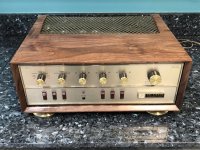In general, high heat reduces the useful life of tubes, electrolytic capacitors, even some resistors.
I'd guess a slow, quiet fan would increase the life more than a Variac, but you could do both.
I'd guess a slow, quiet fan would increase the life more than a Variac, but you could do both.
A bucking transformer on the AC input is cheaper than a variac, yes? I'd feel more comfortable with the transformer type that has primary and secondary windings on separate or "split" bobbins;

Sometimes you can find these in discarded Japanese AC powered audio equipment.
To me it's a fundamental problem with some "vintage" tube stuff, which can present another difficulty in addition to the AC line voltage value; they asked a lot from the output tubes to begin with. Competition wringing the last watt (vs the 1st watt) possible out of a design. 2023 is not the decade when you can just pop over to the local drug store and get a new output tube for $5. Longevity should trump max attainable power output, particularly in the era when the 1st watt counts most -
Sometimes you can find these in discarded Japanese AC powered audio equipment.
To me it's a fundamental problem with some "vintage" tube stuff, which can present another difficulty in addition to the AC line voltage value; they asked a lot from the output tubes to begin with. Competition wringing the last watt (vs the 1st watt) possible out of a design. 2023 is not the decade when you can just pop over to the local drug store and get a new output tube for $5. Longevity should trump max attainable power output, particularly in the era when the 1st watt counts most -
Bucking transform without any remorse!
I have been using it for years in several forms without the slightest inconvenience and in particular on an amp from the 60s which tortured its 7868s, now it is much calmer.
I have been using it for years in several forms without the slightest inconvenience and in particular on an amp from the 60s which tortured its 7868s, now it is much calmer.
First off, thanks everyone for the great insights here. Any suggestions on how to search the Internet for the right bucking transformer (unfortunately I don’t have access to any old Japanese electronics). I found a homemade one on ebay which looks ideal, but it is still $100. I’d like to see if I could diy for less if I can find the right transformer, but so far this is all I’ve found. If I’m just being too cheap then tell me so, and I’ll buy the one on eBay! Thanks again.
All you need is a 12V transformer secondary winding can stand the required current of your Fisher. Something like the Triad F218X or F219X should get the job done.

Does anyone have a procedure for adjusting The phase inverter and dc balance pots on this unit (fisher x-202-c) without an IM distortion analyzer?
If you have a PC and a sound card with a line input, you can use REW for that. You'll have to load the amp's speaker outputs appropriately and probably reduce the signal level with a resistor divider. I've used the oscilloscope function to be sure I'm not overdriving the sound card inputs, which is easily seen. Dial in a good level (versus full scale) on the scope at whatever power rating you want the amp to be measured at and you should be all set.Does anyone have a procedure for adjusting The phase inverter and dc balance pots on this unit (fisher x-202-c) without an IM distortion analyzer?
When you do a spectrum analysis, REW gives the distortion value. You can easily "turn the knob" on those controls to minimize the number displayed, in real time.
Thanks jjasniew! Downloaded rew today and getting familiar with. Will need to build a little resistor divider but should then be good to go!
Another tip, I have a couple-few different USB sound interfaces; they're so cheap second hand these days I dont worry about blowing one up - like I would the Focusrite Scarlet.
Even the cheapest USB guitar interface will be able to resolve distortion at the typical tube amp level no problem; you only need the great input stuff when trying to resolve that sub-sub fraction of a percent, like Neurochrome and XRK are doing with their solid state designs.
Even the cheapest USB guitar interface will be able to resolve distortion at the typical tube amp level no problem; you only need the great input stuff when trying to resolve that sub-sub fraction of a percent, like Neurochrome and XRK are doing with their solid state designs.
thanks. If all I want to do is adjust my amp‘s phase inverter and dc balance, do I need the sound interface or could I just send REW’s SMPTE signal to the amp thru the line out on the sound card while sending the amp speaker output thru the potential divider then back to the scope in REW thru the line in on the sound card?
Yes, I believe I've used it to both generate and analyze simultaneously. The distortion it generates as a signal source is better than my HP function generator. You can see how good it is by directly looping back the output to input and running the same spectrum analysis as you would with the amplifier in the loop. It's always good to have a grasp of the "distortion floor" of your test setup, even though the measured distortion of the tube amp will likely swamp it.back to the scope in REW thru the line in on the sound card?
- Home
- Amplifiers
- Tubes / Valves
- Fisher X-202-C Restoration: Power Supply Voltages too High

